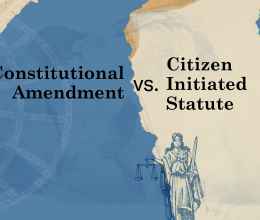In September of 2017, Cleveland.com released shocking surveillance footage of officers at Cuyahoga County’s Juvenile Detention Center standing guard as teenagers fought each other. Grainy footage shows a gray industrial common area, adorned in concrete and linoleum, as a burly detention officer enters with two young men. The officer stands between them with the stance of a seasoned MMA referee, gesturing towards a corner room a little outside of frame as two teenagers trail behind. One follows his lead, taking off his shirt in anticipation, before the door closes swiftly behind him. Another pauses to receive instruction from the officer, swinging lanky limbs, punching clenched fists in air. These orchestrated fights by detention officers were described as “bloody and brutal” in a lawsuit filed against the center.
Weeks later, a second video was released showing a 16-year old boy held at the same facility doused in urine by detention staff. In a clip obtained exclusively by Fox8’s Investigative team, the young man was led into a staff room where he was instructed to sit at a desk facing the table of seated officers. Attention in the room narrowed as an officer doused him in liquid; the teen smelled his shirt in disgust as a second officer raised his hands in celebration.
In January of 2018, Cleveland SWAT teams were called for what was reported as a, “disturbance” at the Cuyahoga Juvenile Detention Center. Six other teenage boys were then charged with additional crimes. Details continue to emerge from this unfortunate incident that escalated all too quickly..
The notion these events are merely random, isolated incidents abetted in the hands of a power -hungry few, are false. Each incident, reported within the span of five months, follows patterns of abuse, mistreatment, and unsafe conditions, all of which are rampant at the Cuyahoga County Juvenile Detention Center. Despite my gratitude for the investigative journalism exposing the nature of disturbing truths, I shudder at the scale of inevitable unknowns; notably unreported incidents left hidden or otherwise unaccounted for.
Juvenile justice systems should adhere to a philosophy of rehabilitation first. Youth are starkly different than adults- more physically, mentally, and emotionally malleable. Nonetheless, detention centers tend to operate like traditional correctional facilities, ripe with opportunities to traumatize under the guise of punitive fixes. And, statistically, they capture our most powerless members of society- mentally ill, low-income, and black and brown youth.
It’s impossible to separate the incarcerated teens from the trauma inflicted upon them and their communities. Juvenile crime must be understood within the context of vulnerable situations; limited employment, barriers to quality education, and dwindling mental health services (to name just a few). Let us not forget Ohio’s lack of meaningful investment in the cities these youth hail from. Politics of urban inequality explain the layered contours of crime and poverty; acknowledging the ways in which crime postures itself as a viable means of survival in the first place.
It is our moral obligation to demand reforms extending beyond forced resignations or shuffling of personnel. We must hold the Cuyahoga County Detention Center directly responsible for violating the civil liberties of the youth confined in their facility. The inter-connectivity of the described events- centralized by the cruelty of corrupt officers and unwillingness to see their youth offenders as people first- speak to violations of our most deeply held principles: equal and fair treatment under the law.
ACLU of Ohio in partnership with the Juvenile Justice Coalition, proposed basic reforms in a letter to Cuyahoga County Officials that the Detention Center should immediately adopt:
- Transparent, Outside Assessment: C.C.J.D.C. is notorious for hurried internal fixes with little to no tangible outcomes. It is clear we need unbiased expertise to provide structural assessments with merit.
- How: Through a steering committee established by the Cuyahoga Juvenile Court (including court personnel, public defenders, youth, community, and detention staff), outside experts will be granted access to the facility to conduct a formal analysis and review assessments from years prior.
- Real Accountability: The progress of any proposed measures must be monitored to ensure reforms have been implemented in full.
- How: Timelines established by the steering committee dictating how and when changes will occur. Regular reporting to both the public and judicial stakeholders to strengthen a framework of timely, responsive reforms.
- Alternatives to Detention: Not all youth require detention to begin their journey of rehabilitation. Jurisdictions across the state and country are working with organizations like the Juvenile Alternatives Initiative (JDAI) to increase access to mental health resources, advocacy, and education, and decrease a dependence on detention. Research shows that these alternatives improve the safety of both youth and staff in the facility, while supporting community-based approaches that keep youth out of the system in the first place.
- How: The Cuyahoga County Juvenile Detention Center is actually a JDAI site. A slew of JDAI resources dedicated towards empowering youth in a positive direction is already made available to them. Furthermore, adequate, consisting funding from the county and the state can aid in smarter, long-term reforms to the system.
Recent rhetoric surrounding the events that occurred on January 8th speak to deep seated prejudice against the young people in the system. Commentary has pegged the juveniles as violent and hostile; racially veiled language to imply the facility teens cannot be redeemed.
Fear mongering will not absolve elected officials and facility leadership from their obligation to heal and rehabilitate. Needlessly arousing public fear in lieu of real solutions only serves to reinforce dangerous, and inaccurate, perceptions of who these young men are. We must proceed with pronounced sensitivity towards the humanity of the juveniles involved- Cleveland’s future depends on it. .







